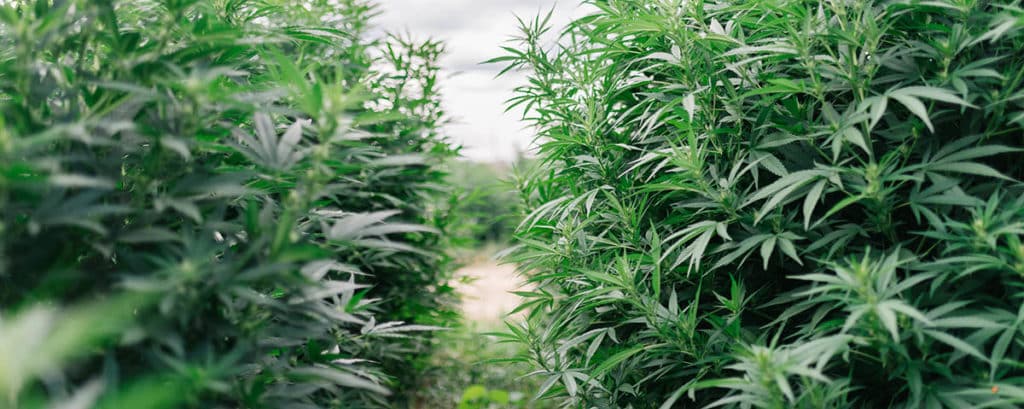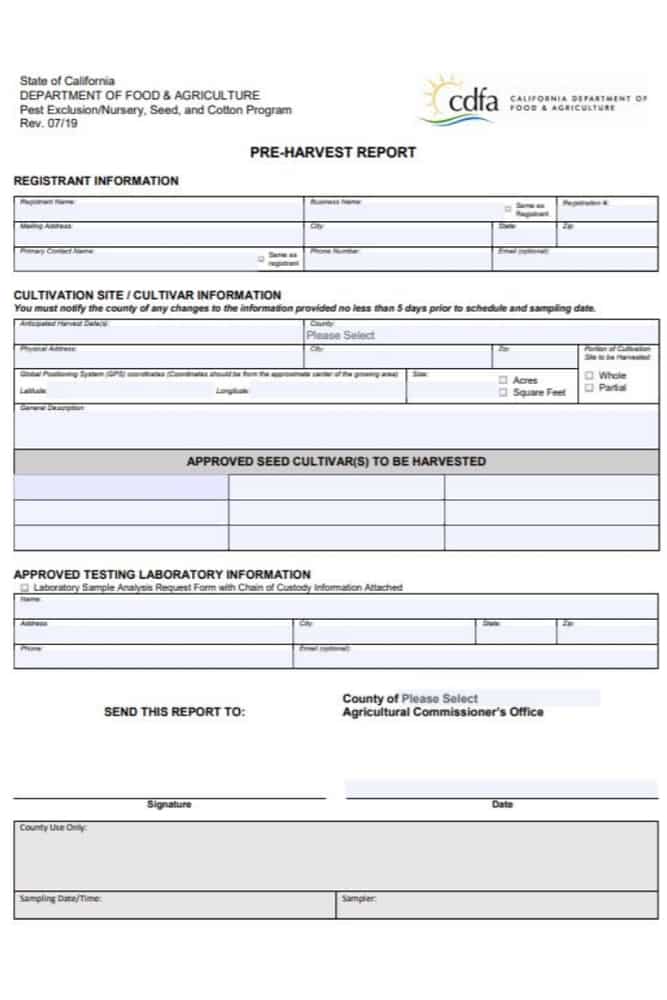Growing
Hemp Farming Harvest Checklist

Farmers of industrial hemp might be understandably eager to reap the rewards of their hard work during the growing season, but going straight to harvest is definitely ill-advised and could result in legal issues. Preharvest is one of the key steps in proving that your product is compliant. During the preharvest stage, there are a few crucial steps a farmer must take before they can enjoy this season’s bounty.
While specifics may vary, each state has similar regulations regarding the preharvest process. Because of the THC content requirements surrounding hemp, preharvest testing is fundamental in proving compliance and assuring a stress-free harvest.
Blue Forest Farms devised a general guide for industrial hemp growers in the United States, to help take the confusion out of the preharvest process. If you follow the steps below and make sure to look up your state’s specific legislation, it’s unlikely you will have issues.
Steps to Success
The steps you take before you harvest your hemp plants are just as important as the steps you take after you harvest your hemp. Set yourself up for success by following the steps in perfect order.
It’s also crucial to make sure you’re complying with local and federal hemp regulations leading up to your harvest.
Whether you’re in the hemp industry to produce hemp fiber, hemp grain, CBD products, or hemp seeds, you’ll still need to comply with legal requirements, such as the 2018 Farm Bill.
- Determine Your Harvest Lots and Dates
Know your harvest date! And if you’ve planted more than one field of industrial hemp cultivars, know which fields you are going to harvest when. You’ll need to enter this information on your Preharvest Report Form. The actual name of this form can vary by state but typically includes the words “preharvest” and “testing” in the name. Typically, the state Department of Agriculture requires that the form be submitted no more than 30 days before your projected harvest date, and that sampling be completed within 15 days of harvest. However, this timing may vary by state so we recommend visiting the Department of Agriculture website for the state where your hemp field is located.
- Fill Out Your Preharvest Report Form

This form must be completed before your product can be tested. As you might expect, it asks for your name, business name (if applicable), and contact information. Additionally, it also asks for your registration number. This is issued to you after you apply for a hemp grower’s license. If you don’t have one of these, well, I’m no lawyer, so I can’t give you advice there. This form will also ask information about your lots, like location and size, in addition to which hemp varieties you wish to sample. Often there’s a section to indicate the lab, which will perform the testing.
Here’s a sample of a typical form. Expect additional pages that explain each field that needs to be filled out. Make sure to strictly follow your state’s guidelines for filling out the Preharvest Report Form.
- Send in Your Form
Send your form to your state’s Department of Agriculture. If you need to figure out where to send these forms, the department’s contact information – phone, email, and mailing address – will be on their website.
- Samples!
The previous steps were an important preamble to the main preharvest requirement: taking samples of your growing hemp. This procedure can vary significantly by state, so make sure you completely understand what your state requires. Usually, once you send in your report, the Department of Agriculture will assign you a sampling date. Some will send a sampler to your fields, and some will expect you to send your sample to the lab by the date assigned. One important thing to note is the recent legislation changes regarding labs that are authorized to test hemp. During the 2021 hemp farming season, all laboratories testing hemp must be DEA approved and test for total THC, not just Δ9THC.
- Results
Once your samples have been processed by the lab, they will contact you with your results, commonly via email. If you’ve started with a strain with good genetics, and you’ve followed farming best practices, you should receive good news. But, anything that tests over .3% THC will have to be destroyed and anything testing at or above .5% could lead to legal penalties. Once you’ve received your compliant results, it’s time for the fun part – harvest time!
Preharvest testing may seem like a daunting process but it is really just a matter of accurate timing and paperwork – fun! You can always use the paperwork as a chance to get off your feet… It is essential that you make sure to sample within 15 days of harvest, as CBD and THC levels continue to change with certain factors like sun and heat as the plants mature. After all your hard work, sit back, relax, and prepare for the harvest process.
Make sure you have your harvest equipment ready. While the harvest process can be a bit labor intensive, having a machine baler or harvester can make the process easier.
What Should You Do Post-Harvest?
You need to know what you plan to do with your plant material before you harvest it because the moment the flowers are separated from the plant, they’ll begin to die. You need to have an immediate plan of action on standby and swiftly move into the next stage to prevent your crop of hemp from going to waste.
When Should You Harvest Live Hemp?
Freshly harvested hemp can be used immediately to make live hemp extracts, like rosin and resin. However, you’ll need to move quickly before the terpenes begin to evaporate. The biggest benefits of live CBD products are their ability to promote the entourage effect and the fact that they remain true to flavor.
If you want to keep your hemp alive and you cannot immediately use it to make CBD resin or rosin, you can flash-freeze it with dry ice to preserve it. You should still use it within a day or two to prevent damage to the hemp flower’s cannabinoid-rich trichomes, which can occur as a result of freezing hemp.
When Should You Dry Hemp?
Have your drying facility prepared for harvest day. Check your high-powered fans to make sure you have adequate airflow, and test the temperature of the room to make sure it stays between 60 and 70 degrees Fahrenheit.
If you haven’t already done so, install a hygrometer, which is a device that measures humidity in the air. The humidity of a hemp drying room should be around 60 percent, and minor fluctuations are normal.
You need to maintain a constant stable humidity level to prevent your hemp from rotting as a result of moisture exposure. You also want to prevent your crop from becoming so dry that the terpenes dissipate.
When your hemp is fully dried, you can cure it in glass mason jars or other large airtight containers to keep the terpenes circulating. Hemp should cure for about six weeks before use, but if the conditions are ideal, you can cure it for as long as six months.
Aim for a long cure if you aren’t sure how you intend to use your hemp. You can create hemp extract to turn it into homemade CBD oil or edibles if you choose, or you can also smoke perfectly cured hemp.
The Wrap-Up on Harvesting and Processing Hemp
Growing your own hemp is a labor of love — we know that better than anyone. Our whole business is cultivating top-shelf hemp and using it to create wellness products for every lifestyle.
We hope you’ll find it as rewarding as we do. If you’re a little overwhelmed by the amount of work that goes into hemp harvesting and hemp production, chill out. Hemp cultivation should be relaxing.
We have ready-made solutions you can use right now if you’d rather skip right to the good part. Learn more about cannabis and hemp with Blue Forest Farms.
Sources:
Hemp Production Program Questions and Answers | Agricultural Marketing Service
Hemp Production and the 2018 Farm Bill – 07/25/2019 | FDA.
https://www.westword.com/marijuana/deas-involvement-in-hemp-worrisome-to-colorado-farmers-11617685
https://hempindustrydaily.com/usda-national-thc-test-for-hemp-as-challenging-as-you-think-it-is/
https://www.sclabs.com/wp-content/uploads/2019/07/Hemp-California-Pre-Harvest-IS-MKT0005.pdf
https://www.oregon.gov/ODA/shared/Documents/Publications/Hemp/SamplingProtocol.pdf



